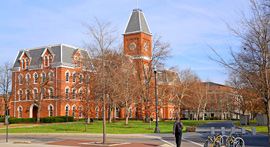Academics
At St. John’s College in Maryland, the “great books,” or texts commonly viewed as the foundation of Western culture, form the backbone of the unique curriculum. St. John’s is a liberal arts college with two campuses that encourages exploration and dissection of original, foundational texts so that students may develop critical analysis skills within a “safe and prosperous learning environment.” “The teaching of St. John’s College is all about allowing individuals to collectively discover the essence of being a human being,” sums up one student. Classes are pretty straightforward: “We read, and we talk about what we read.” The curriculum includes obscure texts as well as the major classic players, and one of the greatest things about studying here is “engaging with difficult and renowned texts without worrying about impressing others or having to show off.”
The “largely brilliant and caring” faculty members at St. John’s are “some of the most wonderful and interesting people,” and are “willing to meet for coffee or lunch to discuss essays, questions from class, concerns, and even non-program texts.” They are “engaged and enthralled by the learning process at St. John’s, just as the students are.” The college has a unique evaluation system in place, so students at St. John’s “are faced with reports not just on their academic success, but also on the way that they treat and interact with their peers, via classroom dynamic.” The college has made academic rigor an “overwhelmingly social issue,” and the “‘too cool for school’ attitude is not socially rewarded” here. Not only do students discuss the same works and questions, “they do so in a respectful, tactful manner.” In any classroom “you get the sense of togetherness” where everyone listens and “no one’s points are any more or less important to the discussion than any other’s.”
Student Body
The student body at St. John’s is “intellectual, but far from pretentious,” and given that all students go through the same academic program “there is a strong and warm sense of camaraderie.” Upperclassmen “couldn’t care less that you’re a freshmen,” and people “who would have never become friends anywhere else are able to come together here and form bonds that start in the classroom but continue into life outside the academics.” The curiosity students develop here extends to outside the program as well, so while the program at St. John’s is classically oriented, students at the college “are aware of pop culture, current events, and politics.” The bubble at St. John’s is “real, but in no way impenetrable.”
Campus Life
There are “no two Johnnies that are alike” and students at St. John’s display a wide range of interests. Most participate in “a study group of some sort, at least one artistic extracurricular, and an intramural sport.” St. John’s “robust intramural program” is a major component of campus social life, and creates a “fantastic” community in which students are alphabetically sorted onto teams “where anyone can participate in various seasonal sports.” “Although I have never been athletic, this is a very welcoming group regardless of ability, and playing intramural sports here has given me a lot of confidence,” says one student. A large amount of extracurricular time is spent studying and reading, but there are also “very many popular club options,” including “swing dance lessons, fencing, the croquet team, student play productions, orchestra, various choral groups, community service, [and the] environmental club.” St. John’s also offers students spots in classes run by non-faculty members of the Annapolis community, including “writing classes, poetry, watercolor, and sculpture.” Off campus, people often go out to eat at many of the great restaurants in Annapolis, or head to the museums and monuments in Washington, D.C., which is “just a short train ride away.” Students can also transfer between the Annapolis or the Santa Fe campuses, and many in Maryland spend a year studying in New Mexico.





